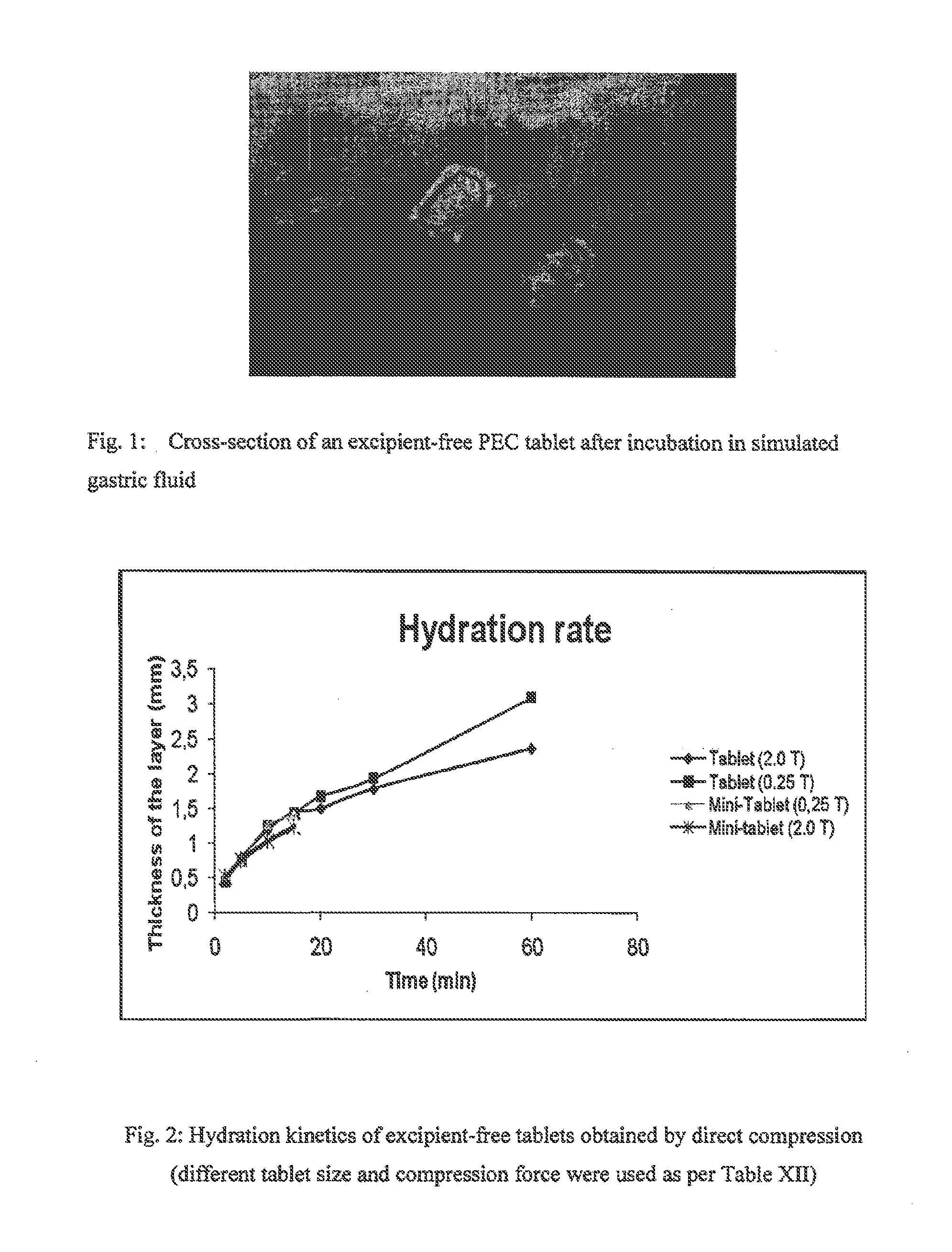Gastro-resistant enzyme pharmaceutical compositions
a technology of gastro-resistant enzymes and compositions, which is applied in the direction of drug compositions, enzyme stabilisation, peptide/protein ingredients, etc., can solve the problems of inability to exhibit satisfactory release profiles, enteric coating preparations often dissolve too late in the upper intestine to make the enzymes unavailable at the desired location, and enteric coating compositions are often inability to release active enzymes. , to achieve the effect of higher drug conten
- Summary
- Abstract
- Description
- Claims
- Application Information
AI Technical Summary
Benefits of technology
Problems solved by technology
Method used
Image
Examples
example 1
Excipient-Free Digestive Enzyme Tablet
[0069]
TABLE IExcipient-Free Tablet (500 mg tablet)(Obtained by Direct Compaction at 2.5T)Tablet ComponentsAmountLipase25,000 USP UnitsAmylase94,000 USP UnitsProtease94,000 USP Units
[0070]Excipient-free tablets were prepared by direct compression of 500 mg of active substance (having the enzymatic activity for lipase, proteases and amylase as mentioned in Table 1) in a die with a diameter of 9.7 mm.
[0071]Smaller tablets as indicated below were also prepared. Each size of smaller tablets were prepared in sufficient number such that their total had an overall mass close to 500 mg. (equivalent to one 9.7 mm tablet).[0072]Tablet 2.0 mm (34 mini-tablets)[0073]Tablet 4.0 mm (8 tablets)[0074]Tablet 6.0 mm (4 tablets)[0075]Tablet 9.7 mm (1 tablet)
example 2
Evaluation of Excipient-Free Pancreatic Enzyme Tablet and Reference Tablet Containing 40% w / w Excipients in Simulated Gastric Fluid and Simulated Intestinal Fluid
[0076]The enzyme activity of the excipient-free tablets of Example 1 and reference uncoated tablets containing excipients was evaluated in Simulated Gastric Fluid (SGF) and Simulated Intestinal Fluid (SIF) as described below. The reference tablets contained 8,000 USP units of lipase, 30,000 USP units of amylase, and 30,000 USP units of proteases and approximately 40% w / w of pharmaceutical excipients. The reference tablets were prepared by direct compression. The results are shown in Tables II-V.
Methods
[0077]Tablets were maintained in a solution of SGF (50 mL) at pH 1.2 or SIF (50 mL) at pH 6.8 at room temperature with constant rotatory stirring (50 rpm). Lipase, amylase, and proteases activities of each sample were measured over time using the inner part of the tablets (i.e., a part of the tablet that was still dry and not ...
example 3
Evaluation of Lipase Activity Determined on the Entire Tablet after Exposure to SGF at Various Time Intervals
[0080]Tablets prepared in Example 1 and Reference Tablets as described in Example 2 were exposed to SGF for 30, 60, and 120 minutes, and the lipase activity of the entire resulting tablets were evaluated. The results are shown in Table V below.
TABLE VEXCIPIENT-FREE TABLET CONTAINING 500 mg TABLETOBTAINED BY DIRECT COMPACTION AT 2.5TRemaining lipase activity after exposure to SGF(% reported to the initial value)Dosage form30 min in SGF60 min SGF120 min SGFExcipient-free tablet64.35 ± 4.1744.24 ± 2.722.90 ± 3.9(example 1)Reference tablet0.00.00.0(containingexcipients)
PUM
| Property | Measurement | Unit |
|---|---|---|
| Temperature | aaaaa | aaaaa |
| Fraction | aaaaa | aaaaa |
| Fraction | aaaaa | aaaaa |
Abstract
Description
Claims
Application Information
 Login to View More
Login to View More - R&D
- Intellectual Property
- Life Sciences
- Materials
- Tech Scout
- Unparalleled Data Quality
- Higher Quality Content
- 60% Fewer Hallucinations
Browse by: Latest US Patents, China's latest patents, Technical Efficacy Thesaurus, Application Domain, Technology Topic, Popular Technical Reports.
© 2025 PatSnap. All rights reserved.Legal|Privacy policy|Modern Slavery Act Transparency Statement|Sitemap|About US| Contact US: help@patsnap.com

